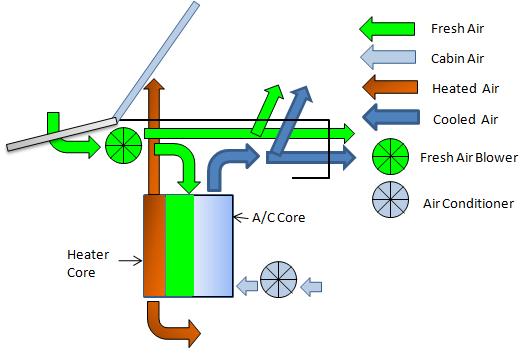Cabin Environment Controls
- Basic Description
-
Cabin environment controls in automobiles are primarily heating and cooling systems. However, the systems found in today's automobiles are much more sophisticated than the systems commonly used in automobiles just a few years ago. Higher end vehicles commonly feature options such as heated and cooled seats, heated steering wheels, and even scent-enhanced air conditioning. Passenger comfort is the driving force behind the environment controls in vehicles, but the impact of these systems goes far beyond comfort alone. With increasing concern surrounding fuel economy and engine emissions, cabin environment control systems have come under the microscope as a potential area of significant energy savings in vehicles. Recent advances have centered around efficiency, weight, packaging and power management issues related to climate systems. The introduction of hybrid vehicles brought an unexpected power management issue to the forefront. Traditional air conditioning units relied on bulky compressors that ran off auxiliary engine power. This posed a problem for hybrid vehicles due to the fact that they regularly operate without the engine running. As a result, manufacturers developed electric compressors. Electric compressors are generally quieter, smaller, lighter and more efficient than their predecessors.
A major focus area in modern climate systems is multi-zone climate control. Traditional systems treated the vehicle interior as one large compartment. The air vents were placed primarily with driver comfort in mind. This would often result in poor circulation in the rear of the vehicle. Some manufacturers included rear vents which required complicated routing ducts and routinely competed with other drive train components for space. These early systems typically did not provide rear passengers with individual temperature control capability. Multi-zone climate control functionality gives individual passengers separate controls for each zone. The HVAC (Heating, Ventilating and Air Conditioning) unit is usually placed in the vehicle's instrument panel or behind the dashboard.
With the increased usage of Air Conditioning/ Heating in automobiles, fogged windshields become a problem as they restrict the driver's visibility. Usually, there are knobs present on the dashboard that help defog the windshield, This process clears the windshield every time a condensation takes place. Today, more advanced systems do not require human intervention to begin the defogging process, as the humidity and temperature sensors, placed at different points inside the vehicle, reduce the AC compressor as and when condensation takes place.

Cabin environmental control systems recirculate the air in the cabin, routing it through a heating and/or air conditioning core that adjusts the temperature and humidity before blowing the air back into the cabin. The microprocessor controls get input from temperature and humidity sensors that are usually located inside the return air ducts. A pressure sensor reads the pressure within the AC system and, in some vehicles, a CO2 sensor determines the amount of carbon dioxide in the cabin to help regulate the amount of outside air that is mixed with the recirculated cabin air. The controller adjusts the air flow by adjusting the position of motor driven dampers in the air ducts.
- Sensors
- Temperature sensors, pressure sensor, humidity sensors, ambient light sensor, gas analyzers
- Actuators
- AC compressor, dampers, blowers
- Data Communications
- Typically Control Area Network (CAN)
- Manufacturers
- Alcoa, Calsonic Kansei,
Delphi,
Denso, HVCC, Johnson Controls, Keihin, Mahle, Preh, TRW, Uriman, Valeo,
Visteon
- For More Information
- [1] HVAC, Wikipedia.
- [2] Automotive HVAC and Cabin Comfort Sensors, Sensata Technologies brochure. (pdf)
- [3] CO2 Air Conditioning, Denso Europe website.
- [4] Car Cabin Air Quality Sensors and Systems, K. Galatsis and W. Wlodarski, Encyclopedia of Sensors, vol. X, 2006.
- [5] Nissan Forest Air Conditioning System, M. Harley, Autoblog.com, July 25, 2009.
- [6] Turning Off Air Conditioning Helps Save Fuel, ScienceDaily, June 28, 2010.
- [7] 2013 Nissan Maxima - Automatic Climate Controls, YouTube, Aug. 30, 2012.
|

